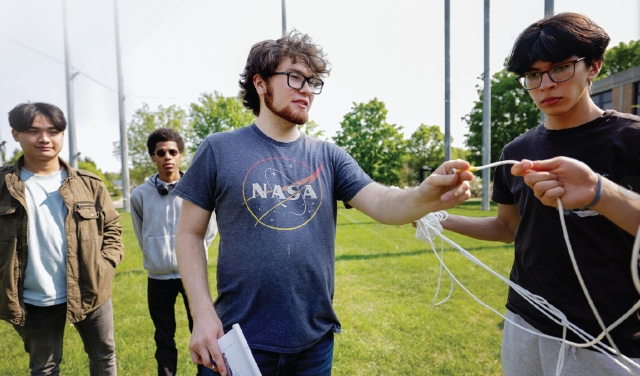CROEM's Radioastronomy Program highlighted in Science
Submitted by Alondra Caraballo Franco on
We share this note published in Science magazine describing a NASA program to educate high school and college students about how space can be explored with radio waves. CROEM High School in Mayagüez is one of several sites across the U.S. and Puerto Rico where students have listened to solar broadcasts using radio antennas they created.
By: Mojtaba Akhavan-Tafti
My class of undergraduate students in the University of Michigan’s Multidisciplinary Design Program stood in the grassy quad and eyed the materials spread out on the ground: PVC tubes, copper wires, coaxial cables, ropes, zip ties, and a radio receiver. Carefully, they began to piece the items together according to their plan. They cut the PVC tubes into four sections and screwed two bolts into each tube—one to attach the copper wire with a zip tie, and the other for the rope to serve as a ground anchor. They connected the copper wires to the radio receiver by the coaxial cables and then hoisted the contraption up on PVC tubes. After 45 minutes, they stepped back to admire their work. They had created a prototype for a radio antenna that high school students could use to hunt for solar radio bursts during extreme space weather events.
The students were fulfilling a request made by NASA’s Sun Radio Interferometer Space Experiment (SunRISE) team, who needed a cheap, easy-to-install, and scalable radio kit to distribute to students around the country. Because this group of undergraduates had previously developed a $25,000 radio antenna as part of their coursework, NASA decided to challenge their creativity. After dividing into teams focusing on hardware, software, and systems integration, the students explored and brainstormed solutions and then worked collaboratively to map each solution to the customer’s needs. After trying numerous combinations, they converged on a dual dipole antenna design (easy to install) using off-the-shelf components (scalable) that only cost $500 (cheap). With NASA’s support, the students fabricated prototypes to test.
We have now shipped more than a dozen antenna kits and educational materials to interested high schools nationwide, free of charge, through a program called the SunRISE Ground Radio Lab. During the October 2023 solar eclipse, high school students around the United States used our antennas to “observe” solar radio emissions and shared their findings with us. We were thrilled to learn that Spanish-speaking students at Centro Residencial de Oportunidades Educativas de Mayagüez (CROEM), a high school in Mayagüez, Puerto Rico, hosted a school-wide event to listen to the Sun using our antenna.









